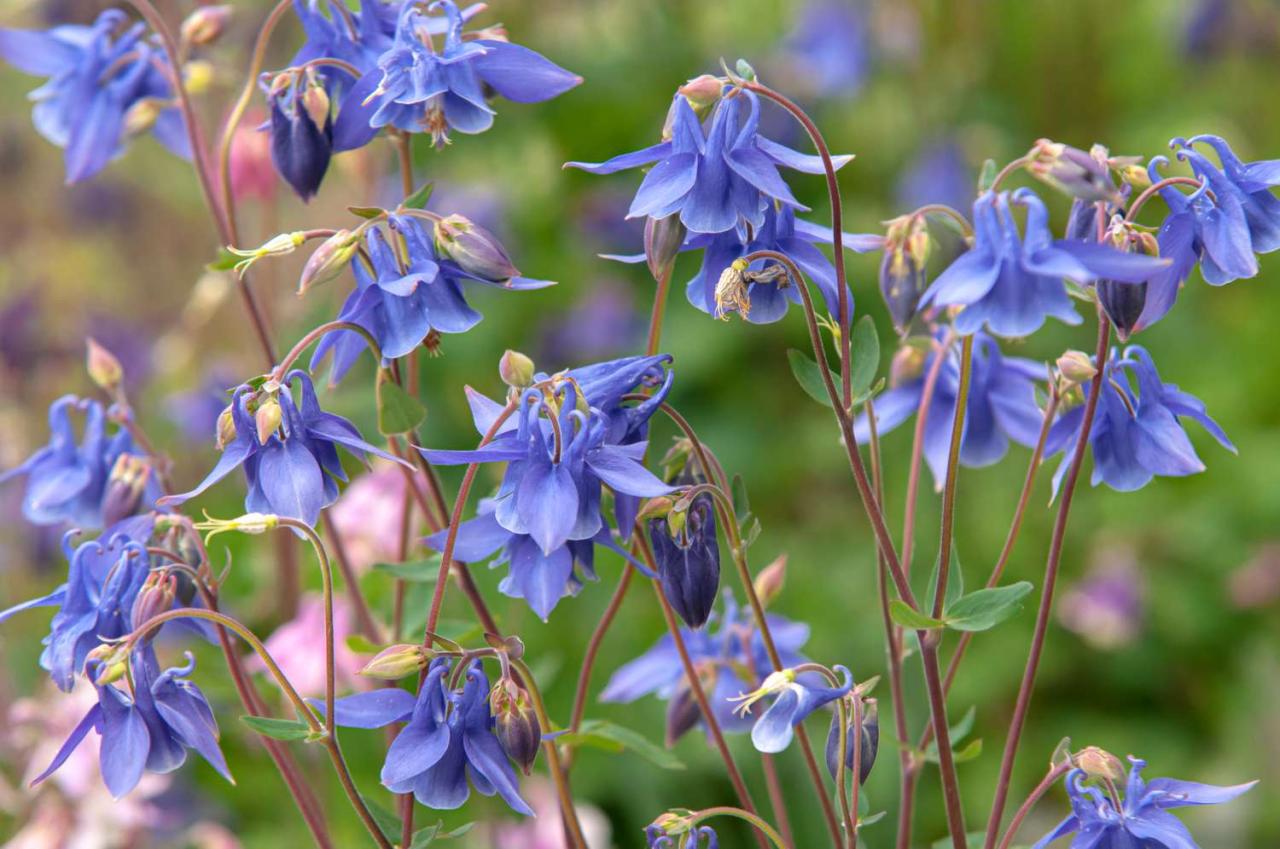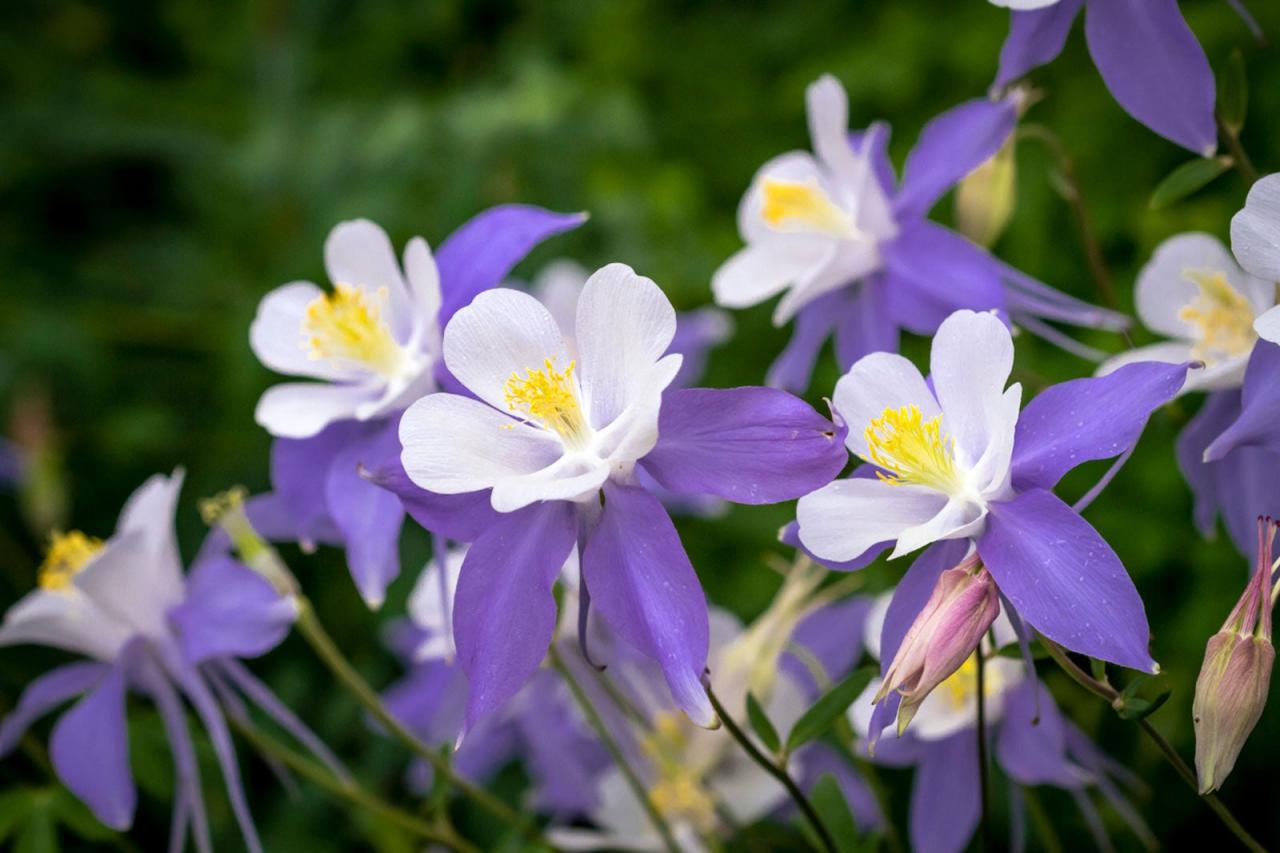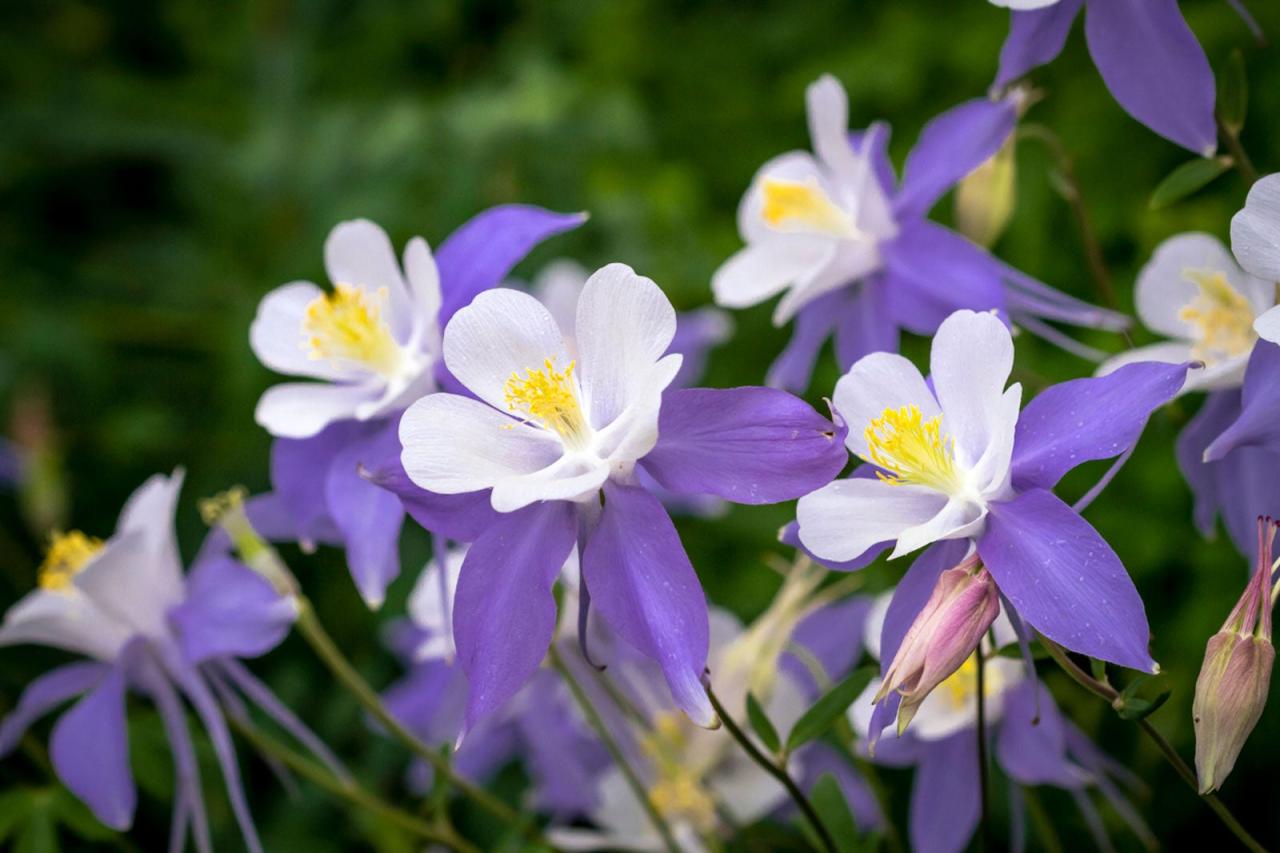Columbine Plants: The Secret to a Stunning Garden, these captivating blooms offer a symphony of color and texture that can transform any garden into a breathtaking oasis. With their delicate, bell-shaped flowers and airy foliage, Columbines add a touch of whimsy and elegance to any landscape.
Their historical significance, dating back to ancient times, adds an element of intrigue, while their adaptability and ease of care make them a favorite among gardeners of all levels.
From the vibrant hues of the common Columbine (Aquilegia vulgaris) to the striking purple blooms of the Rocky Mountain Columbine (Aquilegia coerulea), there is a Columbine species to suit every taste and garden style. Their ability to thrive in a variety of conditions, from sunny meadows to shady woodlands, makes them a versatile addition to any landscape.
Whether you are a seasoned gardener or just starting out, Columbines are a must-have for any garden enthusiast seeking to create a stunning and enchanting outdoor space.
Introduction to Columbine Plants

Columbine plants, belonging to the genus Aquilegia, are captivating wildflowers known for their delicate beauty and unique botanical features. These perennial flowering plants are a cherished addition to gardens worldwide, adding a touch of elegance and whimsy to any landscape.Columbine plants are renowned for their distinctive flower structure, resembling a cluster of five spurs, each containing nectar.
These spurs are often described as resembling the claws of a hawk or dove, giving rise to the plant’s common name, “Columbine,” derived from the Latin word “columba,” meaning “dove.”
Historical Significance and Cultural Relevance
Columbine plants have a rich history and cultural significance, dating back to ancient times. They have been admired for their beauty and medicinal properties for centuries. In ancient Greece, the plant was associated with Aphrodite, the goddess of love and beauty, symbolizing love, passion, and gratitude.
In medieval Europe, Columbine was believed to ward off evil spirits and protect against witchcraft. The plant also played a role in folklore and mythology, appearing in various tales and legends.
Columbine Species and Distinctive Traits, Columbine Plants: The Secret to a Stunning Garden
There are numerous Columbine species, each possessing unique characteristics and traits. Some of the most popular and widely cultivated species include:
- Aquilegia canadensis(Canadian Columbine): Native to North America, this species features scarlet-red flowers with yellow spurs, adding a vibrant splash of color to gardens. It thrives in moist, shady conditions and attracts hummingbirds with its nectar-rich flowers.
- Aquilegia vulgaris(Common Columbine): This species, native to Europe, is characterized by its blue, purple, or white flowers with long, slender spurs. It is a versatile plant, adaptable to various growing conditions, and often found in meadows, woodlands, and gardens.
- Aquilegia chrysantha(Golden Columbine): Found in the southwestern United States, this species boasts bright yellow flowers with long, curved spurs. It is known for its drought tolerance and ability to thrive in hot, sunny climates.
Columbine plants are not only aesthetically pleasing but also provide ecological benefits. Their nectar-rich flowers attract pollinators such as bees, butterflies, and hummingbirds, contributing to the biodiversity of gardens and ecosystems. They are also relatively low-maintenance plants, making them a popular choice for gardeners of all experience levels.
Cultivating Columbine Plants for a Stunning Garden
Columbine plants are known for their delicate, bell-shaped flowers and airy foliage, adding a touch of elegance and whimsy to any garden. To ensure their thriving and captivating beauty, understanding their cultivation requirements is crucial.
Ideal Growing Conditions for Columbine Plants
Columbine plants thrive in well-drained soil with moderate moisture and prefer partial shade to full sun. They adapt well to various soil types, but they perform best in soils that are slightly acidic to neutral.
- Sunlight:Columbine plants prefer partial shade, especially in hot climates. They can tolerate full sun but may require more frequent watering. Morning sun with afternoon shade is ideal.
- Soil:Well-drained soil is essential for Columbine plants to prevent root rot. They prefer slightly acidic to neutral soil with a pH range of 6.0 to 7.0.
- Watering:Columbine plants need regular watering, especially during dry periods. Aim to keep the soil consistently moist but not soggy.
Propagation Methods for Columbine Plants
Columbine plants can be propagated through both seed sowing and division. Both methods are relatively straightforward and allow gardeners to increase their Columbine collection.
- Seed Sowing:Columbine seeds can be sown directly in the garden in early spring or fall. Sow them thinly and cover them lightly with soil. They need a period of cold stratification, which can be achieved by sowing them in the fall or by placing them in the refrigerator for a few weeks before planting.
- Division:Established Columbine plants can be divided in early spring or fall. Carefully dig up the plant and separate the root ball into smaller sections, ensuring each section has healthy roots and shoots. Replant the divisions in a new location with well-drained soil.
Planting and Transplanting Columbine Plants
Planting and transplanting Columbine plants should be done during the cooler months of spring or fall to minimize stress.
- Planting:Dig a hole twice the width of the root ball and the same depth. Place the plant in the hole, ensuring the crown is at soil level. Backfill the hole with soil and gently tamp it down. Water the plant thoroughly.
- Transplanting:Carefully dig up the plant, making sure to get as much of the root ball as possible. Replant the plant in its new location, following the same steps as for planting. Water the plant thoroughly and provide some shade for the first few weeks to help it adjust.
Designing with Columbine Plants
Columbine plants are a versatile addition to any garden, adding a touch of elegance and charm with their delicate blooms. Their adaptability allows them to thrive in various garden settings, from traditional borders to cottage gardens and woodland landscapes.
Color Combinations and Plant Pairings
The vibrant colors of Columbine flowers make them ideal for creating stunning color combinations in the garden. Their hues range from deep blues and purples to soft pinks and yellows, offering a wide spectrum of options for pairing with other plants.
- For a vibrant and eye-catching display,pair Columbines with contrasting colors like orange or red. For example, the deep purple flowers of the ‘Black Barlow’ Columbine can be beautifully complemented by the fiery orange blooms of the California Poppy ( Eschscholzia californica).
- To create a softer and more romantic look,consider pairing Columbines with pastel shades. The delicate pink blooms of the ‘Pink Barlow’ Columbine can be paired with the soft lavender hues of the English Lavender ( Lavandula angustifolia).
- For a natural and woodland-inspired look,combine Columbines with ferns and other shade-loving plants. The delicate foliage of the Lady Fern ( Athyrium filix-femina) can provide a beautiful backdrop for the vibrant flowers of the ‘Crimson Star’ Columbine.
Attracting Pollinators and Beneficial Insects
Columbine plants are a magnet for pollinators and beneficial insects, making them valuable additions to any garden that aims to promote biodiversity. Their nectar-rich flowers attract a variety of bees, butterflies, and hummingbirds, contributing to the overall health and vitality of the garden ecosystem.
“Columbines are known for their ability to attract pollinators, including bees, butterflies, and hummingbirds, which play a crucial role in plant reproduction and the overall health of the garden ecosystem.”
- To attract more pollinators,consider planting Columbines alongside other nectar-rich flowers like Lavender, Salvia, and Echinacea. This will create a vibrant and inviting haven for pollinators, promoting biodiversity and healthy pollination in the garden.
- Columbines also attract beneficial insectssuch as ladybugs and lacewings, which help to control pests in the garden. This natural pest control can reduce the need for chemical pesticides, creating a more sustainable and environmentally friendly garden environment.
Maintaining Columbine Plants for Optimal Growth: Columbine Plants: The Secret To A Stunning Garden
Columbine plants are relatively low-maintenance, but a few simple steps can help ensure their health and encourage abundant blooms. By following a routine maintenance schedule, you can keep your Columbine plants thriving and looking their best.
Routine Maintenance for Columbine Plants
A regular maintenance schedule helps keep your Columbine plants healthy and blooming. This includes pruning, deadheading, and pest control.
- Pruning:Pruning Columbine plants is best done in the late fall or early spring. This involves removing any dead or damaged stems and leaves. You can also prune back the plant to encourage bushier growth.
- Deadheading:Deadheading involves removing spent flowers to encourage the plant to produce more blooms. This process helps extend the blooming period and keeps the plant looking tidy.
- Pest Control:Columbine plants are generally pest-resistant, but they can be susceptible to aphids, spider mites, and slugs. Inspect your plants regularly for signs of infestation. If you find pests, you can use a mild insecticidal soap or neem oil to control them.
Potential Problems and Diseases
While Columbine plants are relatively hardy, they can be affected by certain problems and diseases. Recognizing these issues early can help prevent them from becoming serious.
- Powdery Mildew:This fungal disease appears as a white, powdery coating on the leaves. It thrives in humid conditions and can be controlled with fungicides.
- Leaf Spot Diseases:These fungal diseases cause brown or black spots on the leaves. They can be treated with fungicides.
- Root Rot:This disease occurs when the soil is too wet and can cause the plant to wilt and die. Avoid overwatering and ensure good drainage to prevent root rot.
Extending the Blooming Period and Promoting Longevity
You can extend the blooming period of your Columbine plants and promote their longevity with a few simple techniques.
- Deadheading:As mentioned earlier, deadheading is essential for encouraging continued blooming.
- Fertilizing:Columbine plants benefit from a balanced fertilizer applied in the spring.
- Watering:Water your Columbine plants regularly, especially during dry periods. Avoid overwatering, as this can lead to root rot.
- Mulching:Applying a layer of mulch around the base of the plant helps retain moisture and suppress weeds.
Columbine Plants: A Source of Inspiration

Columbine plants, with their delicate, intricate blooms, have long captivated the hearts of gardeners and artists alike. Their vibrant colors, unique shapes, and graceful forms have inspired countless works of art, from paintings and photographs to poems and literature.
The Diversity of Columbine Flowers
The beauty of Columbine plants lies in their wide array of colors, shapes, and sizes. Here is a table showcasing the diverse characteristics of these flowers:
Color |
Shape |
Size |
|---|---|---|
Blue, purple, red, pink, yellow, white |
Bell-shaped, spurred, five-petaled |
1-2 inches in diameter |
Visualizing the Life Cycle of Columbine Plants
The growth cycle of Columbine plants is a captivating journey, transforming from tiny seeds into graceful, flowering plants. Here is a visual guide illustrating the different stages of Columbine plant growth:* Seed:Tiny, brown seeds with a rough texture.
Seedling
A small, delicate plant with a single stem and a few leaves.
Young Plant
A more robust plant with multiple stems and leaves.
Flowering Plant
A mature plant with numerous, colorful flowers.
Columbine plants are a beautiful addition to any garden, with their delicate flowers and intricate foliage. However, even the most resilient plants can experience challenges. If you’re facing issues with your columbine, it’s important to understand the potential causes and how to address them.
Similar to other perennial plants, columbine can encounter problems like fungal diseases or pest infestations. For a comprehensive guide to troubleshooting common plant issues, consult this helpful resource on How to Troubleshoot Common Rodgers Plant Issues. Armed with this knowledge, you can ensure your columbine thrives and continues to grace your garden with its captivating beauty.
Seed Pod
A round, brown pod containing numerous seeds.
Columbine Plants in Art and Literature
Columbine plants have inspired artists and writers throughout history. Their delicate beauty and symbolic meanings have made them popular subjects in paintings, photographs, and literature.* Paintings:The Dutch master, Jan van Huysum, painted exquisite still life paintings featuring Columbine flowers, showcasing their intricate details and vibrant colors.
Columbine plants, with their delicate, bell-shaped flowers, add a touch of whimsy to any garden. Their vibrant colors and airy foliage create a sense of lightness and charm. But if you’re looking for a plant that truly steals the show, consider the Rodgers plant, a striking and unique addition to any landscape.
Learn how to cultivate this captivating plant and make it the envy of all your friends with this helpful guide: How to Make Your Rodgers Plant the Envy of All Your Friends. Once you’ve mastered the art of growing Rodgers plants, you’ll be ready to tackle any garden challenge, even the most delicate Columbine varieties.
Photography
Modern photographers capture the delicate beauty of Columbine flowers in macro photographs, revealing their intricate textures and vibrant hues.
Literature
In Shakespeare’s “A Midsummer Night’s Dream,” Columbine flowers are mentioned as symbols of love and courtship.
Outcome Summary

From their enchanting beauty to their remarkable adaptability, Columbine plants offer a wealth of possibilities for gardeners seeking to create a captivating and thriving garden. By understanding their cultivation needs, design potential, and maintenance requirements, you can unlock the secrets to growing these enchanting blooms and transforming your outdoor space into a vibrant tapestry of color and texture.
So, embrace the charm of Columbine plants and let their beauty inspire your gardening journey.
FAQ Summary
Are Columbine plants deer-resistant?
Columbine plants are generally deer-resistant, but deer may nibble on them if other food sources are scarce. To deter deer, consider planting Columbines in areas where they are less accessible or using deer repellent sprays.
How long do Columbine plants live?
Columbine plants are typically short-lived perennials, lasting for 2-3 years. However, they often self-seed readily, ensuring a continuous display of blooms in your garden.
What are some companion plants for Columbines?
Columbines pair well with other shade-loving plants, such as ferns, hostas, and bleeding hearts. They also complement flowering plants like foxgloves, lupines, and yarrow.
